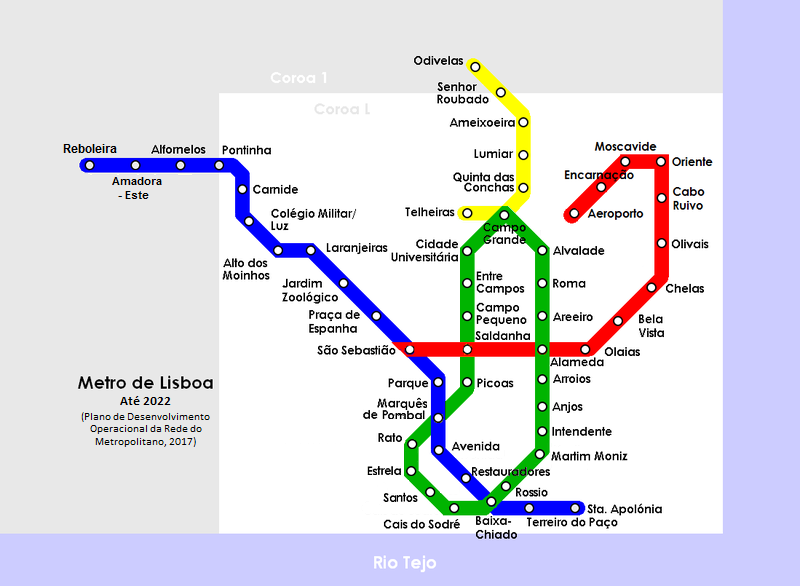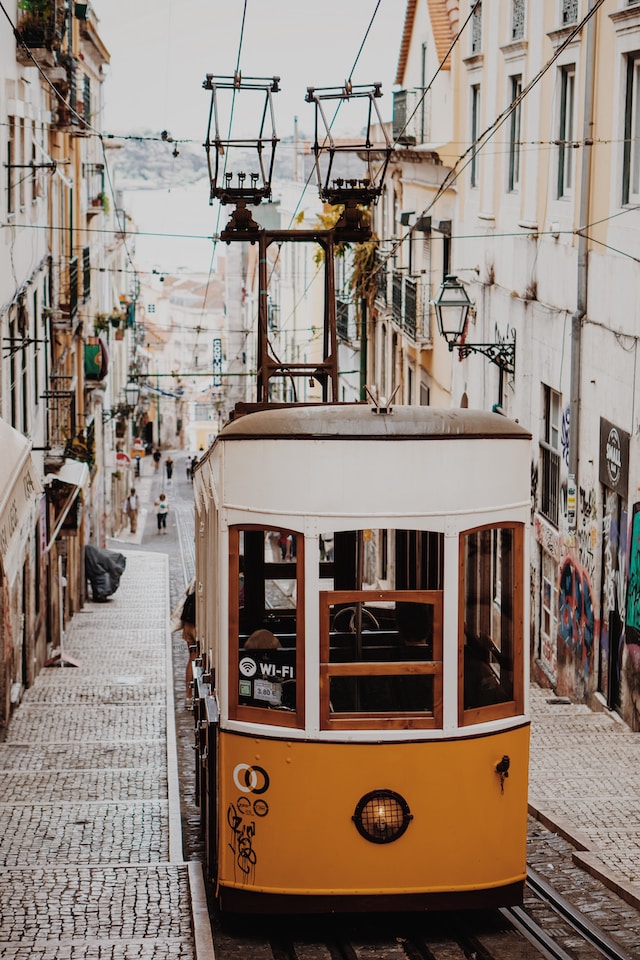Because it is both practical and inexpensive, utilizing Lisbon’s public transportation is one of the best ways to get around the city. The metro, with its many lines and expansive network that reaches most of the city, is by far the most popular mode of public transit. Buses are another option that can be utilized and can be found all across the city, including the downtown area. The Lisboa Card is the most economical choice for tourists visiting Lisbon because it permits unlimited travel on the city’s public transportation systems (including the metro, buses, and trams).
Metro system in Lisbon – Basic information
The Lisbon Metro is a rapid transport system that serves the city of Lisbon as well as the metropolitan area surrounding it in Portugal. It is the most widespread network in the country and consists of four lines that are represented by different colors (blue, red, green, and yellow respectively). It stretches for 44.5 kilometers and contains 56 stations that connect to various forms of public transportation, such as trains and buses, respectively. In addition to that, it features an automated ticketing system with variable fares that are calculated according to the distance of travel. The Metro in Lisbon is not only an excellent mode of transportation but also an easy, quick, and convenient method to go around the city.
The lines of the Lisbon subway system
Blue Line (Seagull Line)
The Blue Line, which is part of the Lisbon Metro and is also referred to as the Seagull Line, is one of the four lines that make up the system. This particular line of the Lisbon Metro is unique in that it is the only one that travels entirely below ground and does not pass beneath any viaducts. The overall length of the route is 14 kilometers, and it consists of 18 stations.
Yellow Line (Sunflower Line)
The Yellow Line, which is part of the Lisbon Metro and is also referred to as the Sunflower Line, is one of the four lines that make up the system. The entire route is 11 kilometers and stops at 13 different stations along the way.
Green Line (Caravel Line)
The Green Line or the Caravel Line is the name given to one of the two lines that are part of the Lisbon Metro system. There are four lines in all. The entire route spans 9 kilometers and stops at 13 different stations along the way.
Red Line (Orient Line)
The Red Line, which is part of the Lisbon Metro and is also known as the Orient Line, is one of the four lines that make up the Lisbon Metro. The entire route covers a distance of 10 kilometers and stops at a total of 12 stations.
Map of Lisbon Metro 2023 – Free Download in PDF

Click on the image and download the map of Lisbon´s underground system for 2023
The Map of Lisbon Metro 2023 is available as a free download in PDF format, and it gives an in-depth analysis of the Lisbon Metro system. It consists of detailed route charts for each of the lines, as well as the locations of the various stations and how close they are to important sites in the area. In addition to this, details on the various ticketing choices, such as single tickets, passes, and travel cards, are included here. With this map in hand, tourists can simply plan their route on the Lisbon Metro system, ensuring that they will get where they need to go without incident and within the allotted amount of time.
Public transport tickets in Lisbon – Best types for travelers & actual prices
As a result of the city’s efforts to improve its infrastructure to welcome tourists, more and more people are opting to use the public transportation system to get around Lisbon. Because there is such a wide selection of tickets and passes to choose from, it may be challenging to identify the one that meets your requirements the most effectively. In order to assist you in making a decision, the following is a guide to the many types of tickets, the rates, and the option that is ideal for travelers who are going to be in Lisbon for three days.
Buying a single ticket for each of your trips throughout Lisbon is a method that is both the easiest and the most cost-effective way to go around the city. These tickets can be used on trams as well as buses, and the price is €1.90 for journeys with up to three stops and €2.90 for longer journeys with more than three stops. The “Zapping” ticket is a reusable card that enables you to make several trips without the need to buy a new ticket for each one. It is recommended that individuals who make multiple journeys in a single day look into purchasing this ticket. The ‘Zapping’ ticket can be used for up to three separate travels during a period of ninety minutes and costs €6.30.
It is recommended to purchase a travel card if you are going to be in Lisbon for more than a day or two, as this will save you money. For a predetermined amount of time, these cards allow the holder to ride on any and all of Lisbon’s public transportation options without restriction. Cards that are valid for 24 hours cost €6.30, while cards that are valid for 7 days cost €18.50. The rates change based on the length of time. At the airport, train stations, and most metro and tram stops, as well as the ticket offices that are located there, you can buy one of these cards to use for your transit needs.
Last but not least, the purchase of a travel card good for 24 hours is your best bet for travelers who will be in Lisbon for three days. This will free you from the obligation to purchase a new ticket for each of your travels, allowing you to take an unlimited number of excursions. Because it provides unlimited travel for one day at a price that is a fraction of what it would cost to buy individual tickets, the 24-hour travel card is also the most cost-effective alternative for individuals who will be traveling for several days.
To summarize, if you plan to use the public transportation system to get around Lisbon, you can choose from a number of different tickets and passes. People who only travel sometimes should purchase single tickets, as opposed to “Zapping” tickets or travel cards, which are more suitable for people who make many journeys throughout the day. A 24-hour travel card is the best option for travelers visiting Lisbon for three days because it allows for unrestricted travel for one day at a price that is a fraction of the cost of purchasing individual tickets.
Timetables & Schedules of Lisbon Metro system
The Metro in Lisbon is operational from 6 am to 1 am from Monday to Saturday, 6:30 am to 1 am on Sundays and public holidays, and from 6 am to 1 am on public holidays. During rush hour, trains on all Metro lines operate typically every 10 minutes, whereas, during off-peak hours, trains run approximately every 15 minutes. There are four distinct areas that make up the Metro system, and riders have the option of purchasing single-ride tickets, as well as daily, weekly, or monthly passes. In addition, children, students, and older citizens are eligible to purchase discounted tickets. Because of its enormous station network and many lines, the Metro in Lisbon is an excellent and convenient method for getting around the city swiftly and conveniently.
What Are Other Options For Public Transportation In Lisbon?
The Portuguese capital of Lisbon is a stunning and historically significant city that is also famous for its efficient and convenient public transit. The city is served by an extensive metro system, which makes it easier to visit a number of the attractions located within the city. Buses, trams, ferries, and even aerial cable cars are just some of the many other modes of public transit that are available in Lisbon. A closer look is taken here at the many modes of public transportation in Lisbon, as well as an explanation of how each one might assist you in moving around the city.
Buses: The bus network in Lisbon is one of the most extensive in the country, with over two hundred routes connecting the various areas of the city. This makes Lisbon’s bus network one of the most comprehensive in the country. Buses have consistent service throughout the day, making them a convenient and inexpensive method to navigate the city’s many neighborhoods.
Trams: There are four distinct tram lines that serve the city of Lisbon. These lines run along some of the most beautiful and scenic roads in the city. Trams are a wonderful choice for those in need of a more leisurely mode of transportation and provide an excellent means by which to discover many of Lisbon’s attractions.
Ferries: The mainland of Lisbon is connected to the surrounding islands of Cascais and Estoril by a number of different ferry routes. Ferries provide an excellent means by which to explore the breathtaking coastline of the area, and the scenery that one encounters while doing so can be breathtaking.
Aerial Cable Cars: In addition, Lisbon is home to two aerial cable car lines, which together offer a one-of-a-kind opportunity to see the city from above. The Santa Justa Elevator is a one-of-a-kind tourist destination in Lisbon, and it features two observation decks that provide breathtaking panoramas of the city below.
There is a diverse range of alternatives available to you in terms of the modes of public transportation in Lisbon, regardless of how you decide to navigate the city. Traveling throughout the city on one of Lisbon’s many buses, trams, ferries, or aerial cable cars is not only an easy and inexpensive way to see the attractions, but it can also be an excellent way to learn about the city’s history.
How To Get From Humberto Delgado Airport (lis) To The City Center With Public Transport?
The Humberto Delgado Airport is Lisbon, Portugal’s primary and most important international airport. It can be found in the northern part of the city and is only around 10 kilometers away from the downtown area. To our good fortune, using public transit to travel from the airport to the central business district is a simple and uncomplicated process.
The metro is the most cost-effective method for traveling from Humberto Delgado International Airport to the heart of the city. The airport’s metro station can be reached in approximately half an hour after leaving the terminal on the level where arrivals are processed. The metro is operational from 7:30 in the morning until 1:00 in the morning, and trains depart every five to ten minutes. The price of a ticket for a single journey is €1.85.
The Aerobus presents travelers with yet another hassle-free way to get between the airport and the core of the city. The Aerobus is a specialized express bus that runs between the hours of 8:00 am and 8:00 pm and departs every 20 minutes. The trip takes about forty minutes total and includes stops at several of the most popular tourist destinations in the city. The price of a ticket for a single journey is €3.
Another option is to take one of the many taxis available for hire just outside the terminal where passengers are arriving. Taxis offer a quick and easy mode of transportation between the airport and the central business district of the city, with the trip taking approximately 25 minutes. The fare in a cab from the airport to the heart of the city is often between 15 and 20 euros.
The Humberto Delgado Airport is generally well connected to the heart of the city, and there are many different ways to get there from the airport. It is not difficult or inconvenient to go from the airport to the central business district of the city, regardless of the mode of transportation you use (the metro, the Aerobus, a taxi, or a rental car).
What kind of sightseeing do you have to see if you visit the Lisbon for the first time?
The city of Lisbon, which serves as the capital of Portugal, is an area that is abundant in history, culture, and beauty. The city is home to a huge variety of tourist destinations, ranging from historic landmarks to cutting-edge buildings and museums. The following is a list of the most popular tourist destinations in Lisbon.
- The Jerónimos Monastery should be your first stop when you are exploring the area. This monastery was constructed in the 16th century and is now recognized as a UNESCO World Heritage Site. It may be found in the Belem neighborhood of Lisbon. Every tourist owes it to themselves to pay their respects at this, one of the most stunning and significant structures in the city.
- The Tower of Belem is an additional top attraction in the city. The Tower of Belem is a fortification that dates back to the 16th century and was constructed with the purpose of guarding the entrance to Lisbon’s harbor. It is one of the most well-known landmarks in the city thanks to the intricate Manueline architecture that it features, and it is also quite popular with tourists.
- Another well-known tourist destination in Lisbon is the Calouste Gulbenkian Museum. This museum is home to one of the world’s most significant private art collections and it can be viewed by the public. It features works of art from a wide variety of countries, including India, Greece, Rome, and ancient Egypt.
- If you want to get a feel for Lisbon’s long and illustrious past, a trip to the So Jorge Castle is exactly what the doctor ordered. This castle, which was built in the 11th century, is located on top of one of the seven hills that make up Lisbon and provides breathtaking views over the city.
- Go to Praia de Carcavelos if you want to have some fun in the sun. You won’t be disappointed. This beach is a terrific place to relax, swim, and soak up some sun because it is located just outside of Lisbon.
- One of the most interesting sights in Lisbon is the Santa Justa Elevator. This well-known elevator was constructed in 1902 and serves the purpose of linking the city’s lower streets with its higher ones. It is an excellent method for getting around the city, and it provides breathtaking perspectives of the urban landscape.
The city of Lisbon is stunning, and there are many points of interest to see there. Lisbon is a city that offers something for everyone, whether you’re searching for some fun in the sun, historical monuments, cultural places, or any combination of the three.
Summary of our tour guide for Lisbon
The city of Lisbon is known for its vivacity and beauty, which contribute to its high number of visitors. The city is famous for its beautiful architecture, its charming streets, and its breathtaking vistas of the Tagus River. In addition to this, there is a diverse selection of public transportation choices available. There are several modes of public transportation, including trams, buses, and even a funicular railway, but the Metro is the quickest and most effective method to get around. Taxis are also accessible, and the airport’s proximity to the center of town makes getting there a breeze. You’ll have no trouble getting where you need to go in Lisbon because of the excellent public transportation system, which makes the city a pleasure to wander around and experience.
Top 5 FAQs and answers about Lisbon public transport?
Can you tell me about Lisbon’s several modes of public transportation?
- There are buses, trams, metro trains, funiculars, and ferries that makeup Lisbon’s extensive network of public transportation. Carris is in charge of the operation of the buses, TramLisboa is in charge of the trams, Metropolitano de Lisboa is in charge of the metro, Elevador de Santa Justa is in charge of the funiculars, and Soflusa is in charge of the ferries.
If I wanted to get around Lisbon using public transportation, how much would it cost me?
- Prices can change based on the kind of transportation that you choose to use. Take, for instance, the price of a single ride on the metro, which is €1.45, in comparison to the price of a single ride on the bus, which is €1.50. In addition, it is possible to acquire multi-trip tickets, which are available for a price reduction.
Is it simple to go around Lisbon by utilizing the various modes of public transportation?
- Using public transportation is a quick and convenient way to move to Lisbon. The city’s public transportation system is dependable and operates at a high level of effectiveness. Because the transportation system is so well-signed, finding your way around is not difficult at all.
Does the city of Lisbon offer any kind of discount to tourists who ride public transportation?
- It’s true that tourists who ride public transportation in Lisbon might get a discount on their fare. Viva Viagem cards, which offer discounts on most forms of public transportation, are available for purchase by tourists. You can purchase one of these cards at any Metro station, a Carris ticket office, or certain tourist information centers.
Do you feel comfortable using the public transportation in Lisbon?
- Using the public transportation system in Lisbon is completely secure, as a rule. Be vigilant of your surroundings at all times, and try to avoid carrying around big quantities of cash if you can help it. This goes without saying for any major metropolis. Avoiding travel late at night by yourself is another piece of advice commonly given.
Useful links







